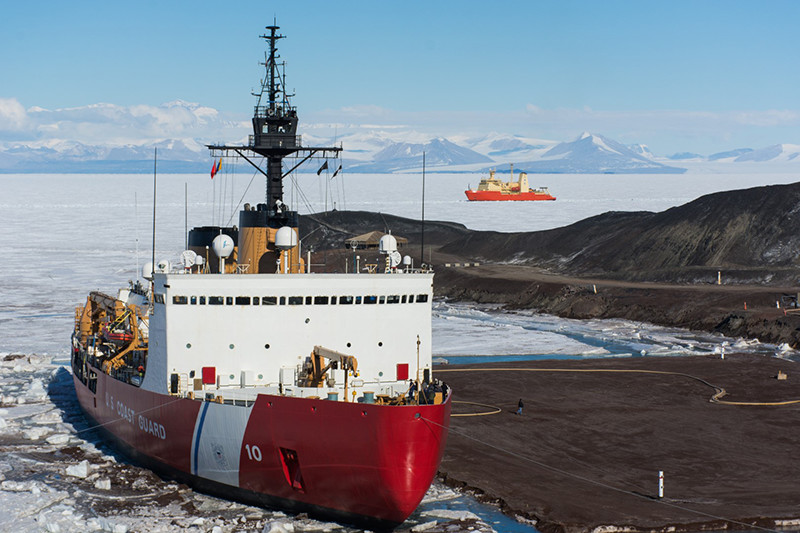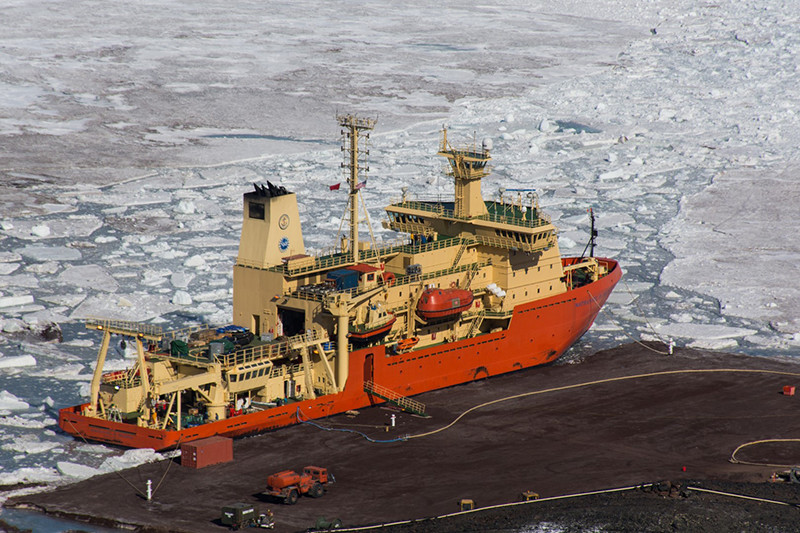
Photo Credit: Mike Lucibella
|
The Icebreaker USCGC Polar Star sits docked at McMurdo’s ice pier, while the research vessel Nathaniel B.
Palmer waits in the channel cut into the ice by the icebreaker.
|
The End of Summer Armada
By Michael Lucibella, Antarctic Sun Editor
Posted February 13, 2016
Over the course of about three weeks, a flotilla of ships docked at McMurdo Station to help both McMurdo and Amundsen-Scott South Pole stations restock and prepare for next year.

Photo Credit: Mike Lucibella
Deck hands offload a shipping container containing hazardous waste from the deck of the Nathaniel B. Palmer.
As the austral summer season draws to an end, an annual succession of ocean-going vessels travel to the station to break a channel through the sea ice, remove unneeded equipment and waste and deliver cargo and fuel. This year was a particularly busy one at the ice pier as the usual complement of three vessels was joined by the National Science Foundation’s research vessel, the Nathaniel B. Palmer.
The first to arrive was the Coast Guard icebreaker USCGC Polar Star, which reached the station’s ice pier on January 17. It sailed from Seattle, Washington to McMurdo to break open a clear path in the frozen sea ice around the station so subsequent resupply vessels can reach the pier.
Every winter the ocean freezes, forming a vast plane of sea ice up to 20 feet thick, off the coast of the station. As summer warms the ice, it melts and weakens, but an ice breaker is still needed to carve—and keep open—a channel from the edge of the ice to McMurdo’s ice pier for the resupply ships to pass through.
The ice breaker had its work cut out for it this season. The sea ice extended much farther north than in recent years.
“We've seen the Polar Star do a break-in that was about 70 miles long compared to its usual 20 miles,” said Paul Sheppard, the McMurdo NSF Representative. “That was a tremendous effort and they arrived at McMurdo in time to bring the Palmer in on schedule.”
The R/V Nathaniel B. Palmer arrived three days later. Coming from the Antarctic Peninsula, on the opposite side of the continent, the Palmer sails to McMurdo every other year to dispose of hazardous waste that Palmer Station can't dispose of on its own. The waste is then shipped aboard the annual resupply vessel to the United States for disposal.

Photo Credit: Mike Lucibella
The Nathaniel B. Palmer docked at McMurdo Station’s ice pier.
In a change over previous seasons, the Palmer sailed with a full complement of science projects on board. Usually on these transects the focus is strictly on transporting waste safely. However in order to further maximize the amount of science done in the program, the research vessel sailed from Palmer to McMurdo with three science projects on board. At McMurdo the three science teams disembarked, and two new groups replaced them for a lengthier Southern Ocean cruise.
On the way to McMurdo the science teams took advantage of the ship’s course to investigate a region not frequently studied. The Science teams deployed buoys to monitor the carbon cycle in the Southern Ocean and the direction of its currents. In addition, the third team took water samples to see the diversity of diatoms, single-celled algae organisms, and how they might respond to climate change.
“It was a spectacularly good trip,” said Sean Bercaw, the marine projects manager for the Palmer. “We had just great conditions and what that allowed us to do was to do some just really incredible science.”
The teams that boarded at McMurdo are both sampling the ocean floor by taking sediment cores. One is looking for evidence in the remains of ancient microorganisms about the history of ice sheets in the region, while the other is looking to better understand the nutrients that ancient organisms consumed.
Two days after the Palmer left for its scientific voyage, the resupply ship Ocean Giant arrived and started offloading cargo containers full of supplies for next year.
At that point the entire station switched into high gear. The station transitioned into 24-hour operations mode to get everything coming off the ship offloaded in a timely manner, and all station waste and retrograde cargo loaded onto the ship for shipment back to Port Hueneme, California, the home base for the U.S. Antarctic Program cargo operations. Leading up to vessel offload, the station population grew as members of the U.S. Navy Cargo Handling Battalion and the New Zealand Defence Force flew in to help load and unload hundreds of shipping containers.
At the same time, the science season on the station started to wind down. Researchers have been finishing their projects and returning to their home institutions while different field camps are being closed down. It’s all part of the support staff’s annual ritual to prepare the station for winter.
The last ship, the fuel tanker Maersk Perry, docked on February 3 and over two days offloaded more than five million gallons of fuel. In the coming year, it will power McMurdo Station, Amundsen-Scott, the numerous field camps and all of the vehicles and aircraft used by the scientists and support staff.
“Fuel is the cornerstone product in supporting the USAP’s mission,” said Chad Goodale, the fuels supervisor for the program. “The offload was as smooth as butter.”







